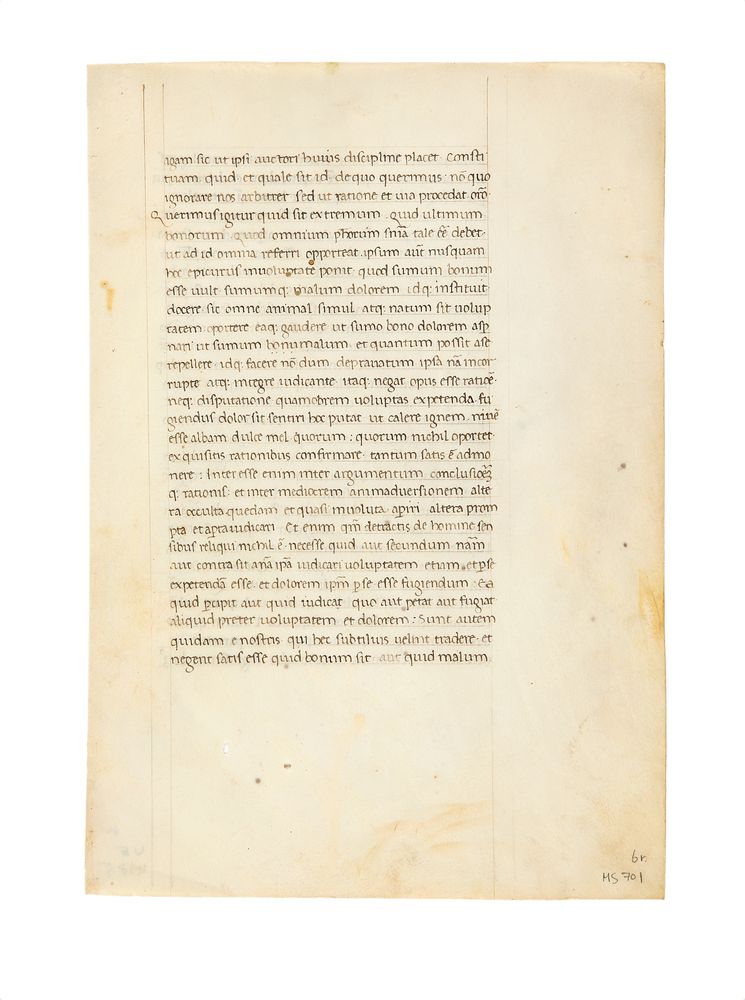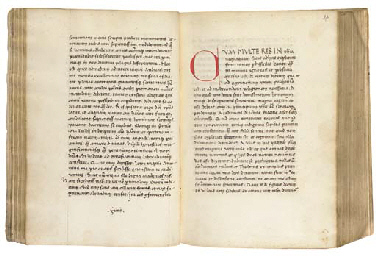Cicero, De Finibus Bonorum et Malorum (on the ends of good and evil), in Latin, single leaf from an illuminated manuscript on parchment [Italy (possibly Ferrara), c. 1463] Single leaf, with parts of book 2, chs. 97-102 (the latter an incipit only), single column, 28 lines in a fine humanist hand, one marginal note “Liberos”, and modern pencil folio number “38”, slight staining at edges and minor cockling, else excellent condition, 258 by 177mm. The parent codex of this leaf was perhaps written and illuminated in Ferrara, and was dated by Ege (a later owner) to 1463. It was offered for sale by Payne & Foss in their cat. of 1825, no. 59, again in 1826, no. 527, and 1830, no. 1111, and sold to Sir Thomas Phillipps (1792-1872), becoming his MS. 4548, and thereafter his sale at Sotheby’s 17 May 1897, lot 198, to Edwards. It was sold again in Sotheby’s, 25 July 1900, lot 1132 to Leighton, and reappeared in the sale of Preston A. Perry’s collection in Anderson Galleries, New York, 21 April 1908, lot 269, to C.L.Ricketts (1859-1941) of Chicago (see S. de Ricci, Census of Medieval and Renaissance Manuscripts in the United States, 1935-40, II, p. 651, no. 220), where it was acquired by the notorious and self-proclaimed ‘biblioclast’ Otto Ege (1888-1951: see S. Gwara, Otto Ege’s Manuscripts, 2013, noting the parent codex of this leaf on pp. 165-66), who dispersed it. Individual leaves can now be found in Rutgers University in New Brunswick (their MC 1220:04), the Beinecke Library, Yale (their MS. 682) and Phoenix Public Library (their MS. Fragment 40). This leaf from a British private collection. Cicero (more properly Marcus Tullius Cicero, 106-43 BC.) is the most well-known and influential of all Roman writers. He was a lawyer and orator, a defender of the Republic against Julius Caesar and Mark Anthony (the latter bringing about his assassination). Petrarch’s rediscovery of his letters in the fourteenth century is often credited as the starting point of the Italian Renaissance. Quintilian (c. 35-c. 100; for whom see lot 40 here) declared that Cicero was “not the name of a man, but of eloquence itself”. As a political theorist his republican ideals inspired both the founding fathers of the United States of America and the leaders of the French Revolution. This leaf comes from a stately humanist manuscript of his explanation of the Greek philosophical schools of Epicureanism, Stoicism and the Platonism of Antiochus of Ascalon (d. 68 BC.). It is dedicated to Brutus, the assassin of Julius Caesar and was written in the summer of 45 BC. It is the least well studied of Cicero’s works. There is no extant ancient or Carolingian exemplar, and the earliest witnesses are those of the eleventh or twelfth century. All Italian copies, including the present fragment, appear to descend from “a small book of Cicero” given to Petrarch by his friend Barbato da Sulmona in Naples, and which circulated among Petrarch’s close associates.
Cicero, De Finibus Bonorum et Malorum (on the ends of good and evil), in Latin, single leaf from an illuminated manuscript on parchment [Italy (possibly Ferrara), c. 1463] Single leaf, with parts of book 2, chs. 97-102 (the latter an incipit only), single column, 28 lines in a fine humanist hand, one marginal note “Liberos”, and modern pencil folio number “38”, slight staining at edges and minor cockling, else excellent condition, 258 by 177mm. The parent codex of this leaf was perhaps written and illuminated in Ferrara, and was dated by Ege (a later owner) to 1463. It was offered for sale by Payne & Foss in their cat. of 1825, no. 59, again in 1826, no. 527, and 1830, no. 1111, and sold to Sir Thomas Phillipps (1792-1872), becoming his MS. 4548, and thereafter his sale at Sotheby’s 17 May 1897, lot 198, to Edwards. It was sold again in Sotheby’s, 25 July 1900, lot 1132 to Leighton, and reappeared in the sale of Preston A. Perry’s collection in Anderson Galleries, New York, 21 April 1908, lot 269, to C.L.Ricketts (1859-1941) of Chicago (see S. de Ricci, Census of Medieval and Renaissance Manuscripts in the United States, 1935-40, II, p. 651, no. 220), where it was acquired by the notorious and self-proclaimed ‘biblioclast’ Otto Ege (1888-1951: see S. Gwara, Otto Ege’s Manuscripts, 2013, noting the parent codex of this leaf on pp. 165-66), who dispersed it. Individual leaves can now be found in Rutgers University in New Brunswick (their MC 1220:04), the Beinecke Library, Yale (their MS. 682) and Phoenix Public Library (their MS. Fragment 40). This leaf from a British private collection. Cicero (more properly Marcus Tullius Cicero, 106-43 BC.) is the most well-known and influential of all Roman writers. He was a lawyer and orator, a defender of the Republic against Julius Caesar and Mark Anthony (the latter bringing about his assassination). Petrarch’s rediscovery of his letters in the fourteenth century is often credited as the starting point of the Italian Renaissance. Quintilian (c. 35-c. 100; for whom see lot 40 here) declared that Cicero was “not the name of a man, but of eloquence itself”. As a political theorist his republican ideals inspired both the founding fathers of the United States of America and the leaders of the French Revolution. This leaf comes from a stately humanist manuscript of his explanation of the Greek philosophical schools of Epicureanism, Stoicism and the Platonism of Antiochus of Ascalon (d. 68 BC.). It is dedicated to Brutus, the assassin of Julius Caesar and was written in the summer of 45 BC. It is the least well studied of Cicero’s works. There is no extant ancient or Carolingian exemplar, and the earliest witnesses are those of the eleventh or twelfth century. All Italian copies, including the present fragment, appear to descend from “a small book of Cicero” given to Petrarch by his friend Barbato da Sulmona in Naples, and which circulated among Petrarch’s close associates.
.jpg?w=400)


.jpg)
.jpg)










Try LotSearch and its premium features for 7 days - without any costs!
Be notified automatically about new items in upcoming auctions.
Create an alert